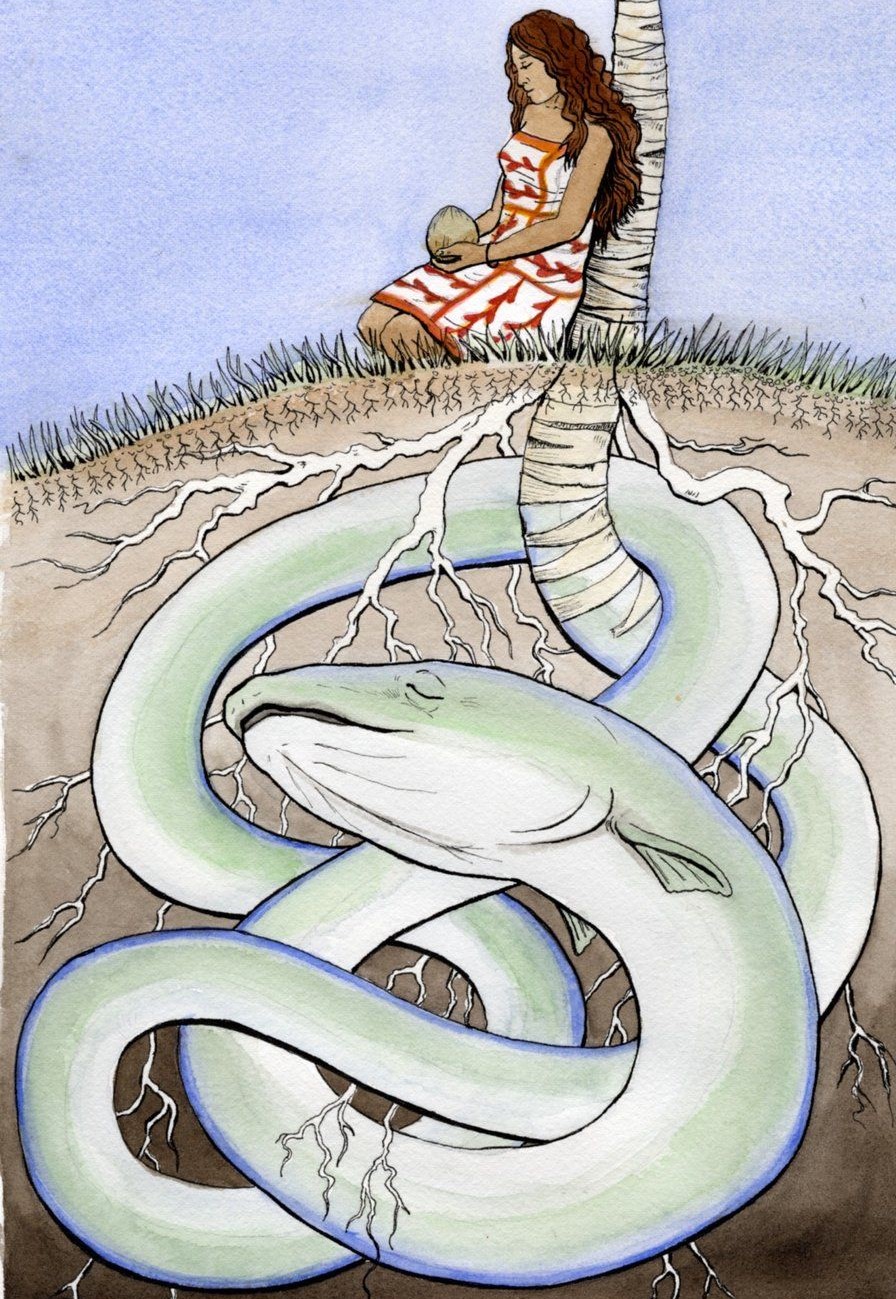Squeal for the eels – amazing migratory fish
Saturday 21 May 2022 | Written by Te Ipukarea Society | Published in Opinion

Celebrating World Migratory Fish Day with fishy eel facts and the tale of Hina and eel. Photo: Pinterest/22052032
Last week we did a shout out for some of the migratory birds that visit us in the Cook Islands. This week, it is the fish that are getting their time to shine, because today is ‘World Migratory Fish Day’, writes Te Ipukarea Society.
We decided to join the party by sharing some fishy tales about one of the Cook Islands’ most interesting migratory swimmers, the freshwater eel. Known locally as tuna.
Being large, fatty and easy to catch, eels have long been an important and delicious food source. The most common of the three freshwater eel species that are native to the Cook Islands, is Tuna Māori, also known as the Pacific Shortfin Eel.
The Tuna Māori has also featured in Cook Islands legends in the commonly told story of Ina (or Hina or Sina in some islands) and the eel. Ina, who fell in love with Tuna, god of eels, was forced to cut off her lover’s head and bury it. Tuna’s head grew into a coconut tree, with the face of Tuna, his two eyes, and mouth still present today on the coconuts we love to drink and kiss at the same time.
From legends to facts, did you know that eels not only breathe through their gills, but also through their skin! This, together with its slippery reputation, gives the eel a slimy advantage for travelling over land such as wet grass or mud. Often in the dark of night.
Eels are hungry for bugs, small fish, fish eggs, worms and crustaceans like the freshwater koura. They are very strong and have a clever ability to reverse at speed, manoeuvring forward and backwards, quickly and easily. Yet another slimy superpower.
Freshwater eels have a truly astonishing life cycle. They wait until the end of their lives to spawn, which can be up to 100 years or more. This means that if you do see a large eel in the kauvai, it will likely be a very old eel which has not yet had a chance to reproduce. The best way to really know an eel’s age, like most fish, is to measure the ear bone (otolith) of a dead eel. Like an old tree, the ‘rings’ of the eel’s ear bone can reveal its many secrets.
After a lifetime in freshwater, the mature eel eventually makes its long and dangerous journey to the sea, swimming thousands of miles to spawn in the very deep ocean, before it dies.
Pacific Shortfin Eels are thought to spawn east of Tahiti. The eggs hatch into tiny little eel larvae that are flat, see-through and shaped like leaves.
They’re called leptocephalus (sounds a bit like lepto–seff–a–luss).
By nature’s miracle, these little leaf-shaped larvae float gently back on ocean currents for many months. The strong South Equatorial current sends them westwards across the Pacific Ocean. Astonishingly, some of these larvae do actually find their way towards a freshwater stream that flows out from a tropical Pacific Island. Hopefully one of ours, in the Cook Islands.
Before entering the streams, the larvae morph again into ‘glass eels’ which are tiny see-through baby eels. These colour-changing glass eels turn black as they swim up the river and become ‘elvers’, which are just like miniature versions of adult eels.
If the elvers are lucky, they will find a healthy clean stream that is kept nice and cool thanks to the overhanging trees, which has plenty of yummy bugs, living in the many streamside plants. Hopefully, there are no nasty high pipes or culverts, road crossings or tricky concrete dams for the little elvers to somehow jump. Fingers crossed, the water is also free from fertiliser or sprays from the nearby fields and no animals have been stomping through the water, making it hard for fish life to see or breathe.
And so begins again, the fascinating life cycle of one of our magnificent, migratory fish of the Cook Islands.
Happy World Migratory Fish Day, and Best Fishes!




































